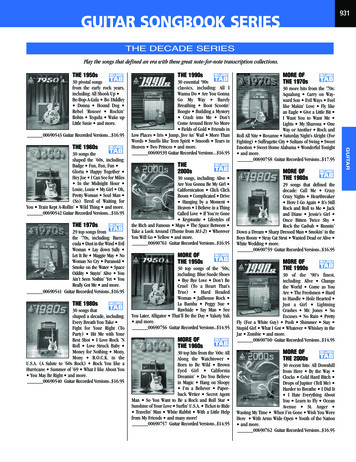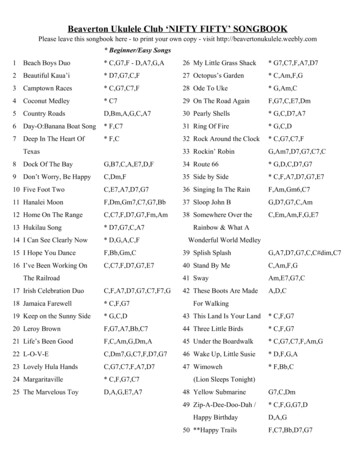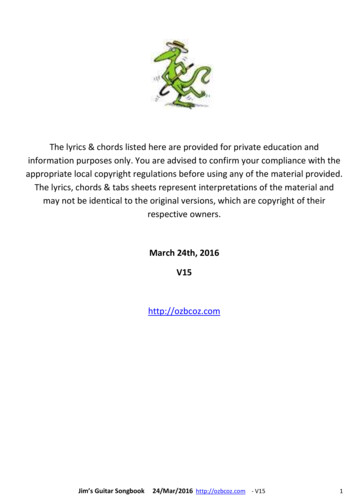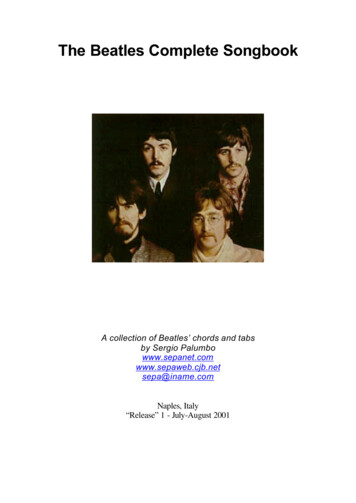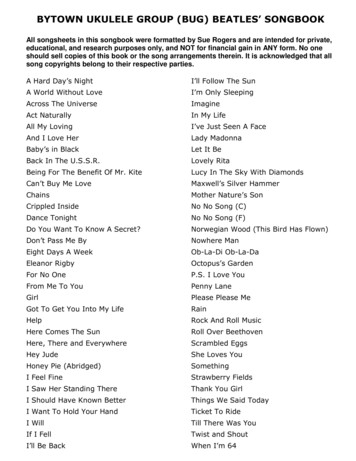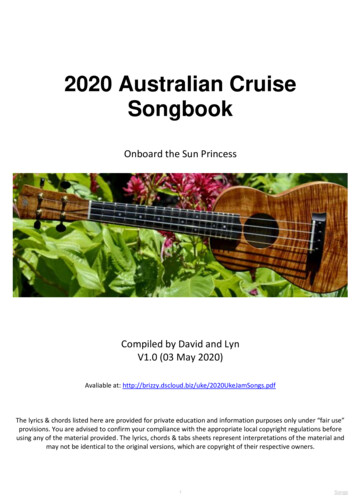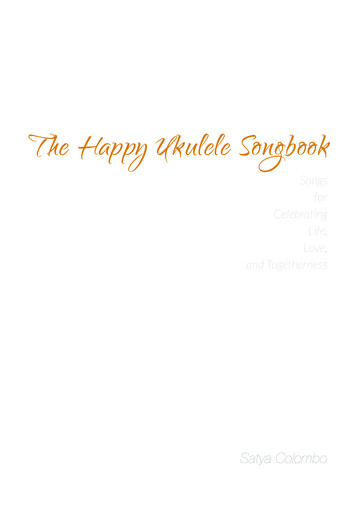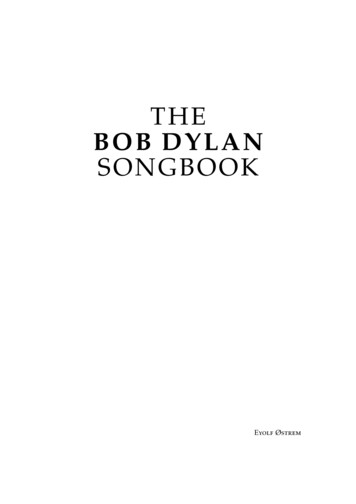
Transcription
T HEB OB DYL A NSONGBOO KEyolf Østrem
Created by seal (commit dbe7ec4).Typeset using LATEX on June 29, 2020.
ContentsPrefaceRoadmaps for the SoulHarp Keys1 Bob Dylan2 The Freewheelin’ Bob Dylan3 The Times The Are A-Changin’4 Another Side Of Bob Dylan5 Bringing It All Back Home6 Highway 61 Revisited7 Blonde on Blonde8 John Wesley Harding9 Nashville Skyline10 Self Portrait11 New Morning12 Pat Garrett & Billy The Kid13 Dylan (A fool such as I)14 Planet Waves15 Before the Flood16 Blood on the Tracks17 The Basement Tapes18 Desire19 Hard Rain20 Street Legal21 At Budokan22 Slow Train Coming23 Saved24 Shot of Love25 Infidels26 Real Live27 Empire Burlesque28 Biograph29 Knocked Out 439441497575599601617619641661681701703725747Down In The Groove31 Oh Mercy32 Under The Red Sky33 The Bootleg Series 1-334 Good As I Been To You35 World Gone Wrong36 Unplugged37 Time out of Mind38 Live 196639 “Love And Theft”40 Live 197541 Live 196442 No Direction Home43 Modern Times44 Tell Tale Signs45 Together Through Life46 Christmas In The Heart47 Tempest48 Shadows in the Night49 Rough And Rowdy 85112311571179120912371253A Early Acoustic Bob(More or less) Electric BobC Rolling Thunder RevueD 1978 World TourE Gospel periodStudio outtakes, soundtracks etc.G Live covers1285141514391451145714971553Song Index170730BF
PrefaceA while ago, I got a mail from a guy down in Germany. It said:Should you be interested, I have converted some of your html tabsto LaTeX, because I created my own Dylan songbook and wantedit to look as good as could be.There were also some pdf files of a couple of songs. To be honest, I didn’tthink much about it – I didn’t really see how a LaTeX version of ‘some of thetabs’ would ever be useful for me. LaTeX – that wildly complicated markuplanguage which claimed to produce the most beautiful output, typographically, but at the cost of a steep learning curve, and a default output whichmakes everything look like something from a mathematical journal (becausethey are all made in LaTeX).I answered back, politely, I think (I hope). The reply I got in return mentioned something about making a whole book that one could take to the localcopyshop and get bound.I still wasn’t too impressed; I already had such a file – Adobe Acrobat couldmake the whole site into a big PDF file in a whiz, so why should I considerthis anything special?Well, in the end, I did, and I do, with ever greater thrill, joy, and inspiration,and the project, from which you are now reading this, has not only turneddylanchords.com into a beautiful book, it has also become a story of friendship,intellectual stimulation, and inspiration to learn, which has – among otherthings – led me (slowly, slowly) to pick up my programming attempts where Ileft them in college, after I had made a semi-functional version of Minesweeperwith 8 12 squares in Basic (remember? the programming language which theschool authorities in the eighties thought that everyone needed to learn, nowthat the computer age was coming); in the end, it also led me to finally ditchingWindows in favour of Linux, something I should have done a long time ago.What Seal can doBut first things first.This book – I quickly learned that it was not simply a matter of stuffingall the tab files into a PDF file and that was that. For instance, print out some
pages from the tab files on the net and try to play from that, and you willsooner or later – sooner, I’d guess – run into tab systems which are divided inthe middle, or verses which have the chords on one page and the lyrics on thenext.Then turn to page . . . – no, wait: any page – in this book, and you will findeverything to be where it should be. Page breaks break pages, not songs.If you’re reading this directly from a PDF file, you will also be able touse the index and the table of contents as a link page – quite handy for a1500 pages book, and nothing that my Adobe-generated PDF dump couldever dream of.And new additions to the site? Changes, revisions? No problem – they areincorporated directly the next time you run the program (as long as you havethe updated files, of course).You want just a booklet with the songs from Empire Burlesque instead ofthe whole book? Sure, make some small changes to one file, and you haveyour ‘Love Songs from the Eighties’ hit parade collection in your hand.And last but not least: it looks good. There are details which distinguisha professionally printed page from what you dump from Your Average WordProcessor to your printer. Some of them are considerable (such as fonts: if YourAverage Word Processor is called MS Word, your font will by default be TimesNew Roman or Arial – bad choices, whichever way you look at it), other aremore subtle and will most likely not be noticed by anyone without a specialinterest or a trained eye. Yet, I happen to think that they are important, notonly for the typography freaks who delight in the perfect curve of a Garamond‘n’ and who take it as a personal insult if page margins aren’t proportionedaccording to the Golden Section. But in an age when most reading is doneeither from computer screens or from printouts from browsers or MS Word,where not a thought has been given to the visual appearance, I see it as theresponsibility of anyone who produces text to make sure they are appealing; tocounteract the print world’s equivalent to elevator muzak. It is my firm beliefthat good typography will not save the world, but that bad typography ruinsit just a little. Seal counteracts this – not bad for a piece of guitar-strummer’shelper software, eh?All this and more is done magically by Heinrich Küttler’s creation, Seal.Here’s what it does, as seen from a layman’s perspective: it takes all the filesfrom whatever version of Dylanchords you have got; turns it all into LaTeXfiles, where hyphenations, page breaks, fonts, layout, and what not is takencare of; generates an index from this; and outputs it to PDF or postscript. Andvoilà – you have a book in your hands, which rivals any chord book you canbuy, both in terms of layout quality, and of usability and versatility.In order for it to work, there was a whole lot that had to be done with thefiles on the site. When I started making the site in 1997, I didn’t know muchabout html, and I used software which knew even less. Over the years, thishad resulted in a jumble of files, some of which were ok, many of which werehorrible, and none of which were valid files, in any definition of html.But Heiner had put together a script which did away with the worst outgrowths, and from there, I could clean out the rest. In May 2005 the files weregood enough to replace the old ones. Thus, Seal turned out to have benefitsbeyond the use of Seal itself.6
That is just about all I can tell you about it; for the technical details, askHeiner. What I know is: it works!What you can do What you can do? Well, you can do anything you can with any other pdf file,such as: print it out or send it to your friends, but that’s not what I was goingto say. The contents is released under the Creative Commons (CC) licence.This means that you are free – and encouraged:to copy, distribute, display, and perform the workto make derivative worksas long as you:attribute the work in the manner specified by the author or licensor, anddon’t use it for commercial purposes.If you alter, transform, or build upon this work, you may distribute the resulting work only under a license identical to this one.In other words: just like the dylanchords site, the contents is distributedfreely, available for anyone who wants to play some good music, and – hopefully – learn something along the way. The conditions are that the attributionis retained, that you don’t make any money from it (I don’t count the free beeryou get, playing from it in your local pub), and that if you use it in a “derivative work”, e.g. include it in teaching material or make your own book, thisnew work should also be made publicly available under the same conditions.The intention is to make sure the material is and will remain freely available, but without abandoning all control. That is why the CC licence is alsolabeled “Some Rights Reserved”. It is not a complete “copyleft”.It goes without saying that this applies only to the parts of the contentswhich is in some way or another my “intellectual property” – the introductionsand instructions, of course, but even the chord charts fall under this category,even though Bob Dylan, as the copyright holder of the original work, hasthe right to decide about their publication. The same, naturally, goes for thelyrics (where my contribution is more modest: correcting some errors in thepublished versions, and, probably, adding some new ones).I’ve been hesitant to put a CC banner on the site before because of this – Iwouldn’t want to postulate a publishing licence for Dylan’s work – but I nowfeel more confident and justified, both because the context is different, andbecause I now know more about the legal issues involved.For me, this is a way of responding to the statement “Everybody must givesomething back for something they get”. Working this closely with Dylan’smusic over the years has given me tremendously much: a deeper insight inone of the most remarkable musicians in modern Western culture; a peek intothe musical universe populated by the likes of Dock Boggs, Woody Guthrie,heck, even Hank Williams, which I would otherwise never have touched butwhich has been opened up with Dylan as a guide; some great friends; somehtml skills; and an opportunity to tune my ear (and my guitar). This is myway of paying back.7
Roadmaps for the SoulGeneral principlesJust a few words about the principles that (mostly) have been followed in making the tabs on this site.First of all: this is a guitar site, not a “chord” site. The ideal “readers” Ihave in mind are the average (or average-to-good-to-very-good) guitar players,playing for their own enjoyment (let’s not talk about the neighbours – just lovethem). That means on the one hand that I transcribe the songs into what isconvenient to play on a guitar, not necessarily into what is actually sounding– in other words: I use the capo, just like Bob Dylan himself. Just because asong happens to be played in the key of Eb major, doesn’t mean that it has tobe tabbed in that key, when it is actually played in “C major” with a capo onthe third fret.2. A corollary of this is that my aim is not just giving the chords of a song,but also to figure out as exactly as possible what is being played in the versionup for study.3. On the other hand there is the problem of the “piano songs” and the“full band songs”. Whereas Dylan prefers (or preferred; things have changed)the keys of C major and G major on the guitar, he delights in odd, awkwardkeys with lots of black keys, especially C] major (or D[ major), when he’s atthe piano. In these cases it is of course impossible to reproduce exactly what isbeing played. I still use a capo (of course). In the “full band songs” – especiallyin later years – Dylan usually just plays the chords, in any position, usuallywith barre chords somewhere up on the neck.This means that there are three main types of tabs/chord-files on this site,corresponding with three kinds of arrangements: (1) The solo acoustic songs,or songs where the guitar work is of some prominence. Here exactness is agoal. (2) Then there is the big group of songs where no particular instrumentis prominent, least of all Dylan’s guitar. Here the aim of the tabs is to presentan approximation of what is going on in the song, rather than figuring outexactly what Dylan is playing (which in these cases is quite uninteresting,actually). (3) The piano songs constitute a sub-division of this group.Many of the tabs are of rare live songs. I presume that anyone who wouldwant to use the tabs already knows what the songs sound like. Therefore,more specific performance indications, apart from the fingerings, are considered unnecessary.
Chords and Chord NamesChords and scales – a little theory and some terms. A chord is a selectionof tones which are perceived as a unity and not just as several notes soundingat the same time. It gets its special character to a large extent thanks to theplace the tones have in the tonal system, which, slightly simplified, means thehierachical system of relationships between the relevant tones of a song or astyle in general. In C major, the tone c is more central than a, which again ismore central than f sharp.It is customary to arrange the available tones in a scale, a “ladder”, and torefer to them according to their position in the scale. The keynote is called“prime”, the tone above it “second”, the next “third”, etc. Thus, the tones in aC major scale would be -------------------------cdefgabc’prime second third fourth fifth sixth seventh octaveThe most weighty tones in the scale are the prime (or unison), the fifth, andthe third (in C major: c, g and e). Then follow the remaining tones in the mainscale (d, f, a, and b), and lastly the tones that are extraneous to the scale: thesemi-tones (f sharp, e flat, etc.)I mention the fifth before the third, but they are important in differentways. The fifth is stable, a loyal companion to the prime, always there, notwithout its conflicts, but they are always resolved, and always in favour of theprime – somewhat like a good old (or bad old, depending on the perspective)patriarchal marriage. In fact, one might consider all music within the westernmusical tradition (until the late nineteenth century in the art-music tradition,and un
29.06.2020 · 1500 pages book, and nothing that my Adobe-generated PDF dump could ever dream of. And new additions to the site? Changes, revisions? No problem – they are incorporated directly the next time you run the program (as long as you have the updated files, of course). You want just a booklet with the songs from Empire Burlesque instead of the whole book? Sure, make some small changes to one .
